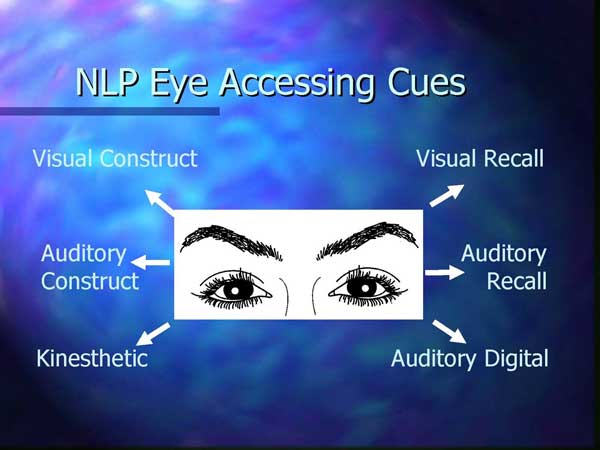WordPress database error: [Table 'adding_b51201.wp_SBConfiguration' doesn't exist]select * from wp_SBConfiguration where id='1'
Welcome to Module 5.3 Return to Dashboard
Module 5.4
Module 5.5
Module 5.6
As you’ll notice when people think, when people get information from their memory or their imagination, their eyes move. If they already have the information, their eyes don’t need to move, but otherwise, their eyes move to the sides and up or downwards. And there’s actually a system to it, so that sometimes you see people get the information they need in the same way, and their eyes move in the same direction.
Research verifying that eye movements correlate with use of specific areas of the brain first emerged in 1972 (Kinsbourne, M. “Eye and Head Turning Indicates Cerebral Lateralisation” Science Magazine 179). NLP Trainer Robert Dilts showed in 1976 that specific brain wave patterns and types of “thought” were related to eye movements in the following way (this map is drawn for a right handed person. In about half of cases, a left handed person will have the left and right sides reversed. Very occasionally, a right handed person will also be reversed. Either way works fine).

Visual construct:
Seeing internal pictures made up by the person, or viewed differently to how they were in real life, (eg., what does the back of your head look like now?)
Visual remembered:
Seeing internal pictures, of things you’ve seen before as you saw them through your eyes, (eg., what colour are your bedroom walls?)
Auditory construct:
Hearing words or sounds put together in new ways, (eg., what would your favourite song sound like if a budgie sang it?)
Auditory remembered:
Hearing sounds as you heard them through your ears (eg., what does your front door sound like when it shuts?)
Auditory digital:
Talking to yourself, (eg., if you were going to give a talk to a group about the way the brain works, what’s the first sentence you’d say?)
Kinesthetic:
Feeling both the internal body feelings that go with an emotional state and the sense of movement or touch, (eg., which carpet in your house feels the softest to walk on?).
There are many ways you can use this information about how people think. One is to enhance your own memory. For most people, looking up to the left is the best way to get their brain to remember visual images (how to spell words, where the right labels go on a diagram, etc.). Studies by F. Loiselle at the University of Moncton, Canada, show that teaching students to look up and left immediately increases their ability to learn and remember the spelling of words by 61%. Thomas Malloy at the University of Utah showed that teaching this simple strategy was twice as effective as drilling students in the older auditory phonics spelling method, (see Robert Dilts and Todd Epstein’s book Dynamic Learning, 1995).
For now, you can do a very simple exercise to begin noticing the eye movements. Get together with a friend and ask the other person to tell you what they like and don’t like about where they are living now. As they reply, watch their eye movements. If you’re the person talking, remember that the usual “look to talk” rule that prevails in some western cultures (where you look at the person you’re talking to) doesn’t need to apply just now! After the person has talked for a couple of minutes, the person observing will give them some feedback about where their eyes are moving. Just be curious.